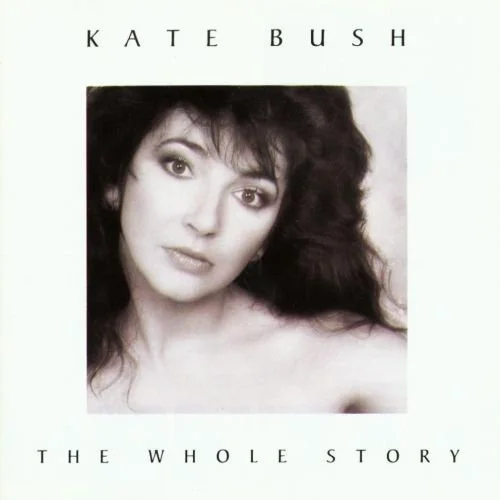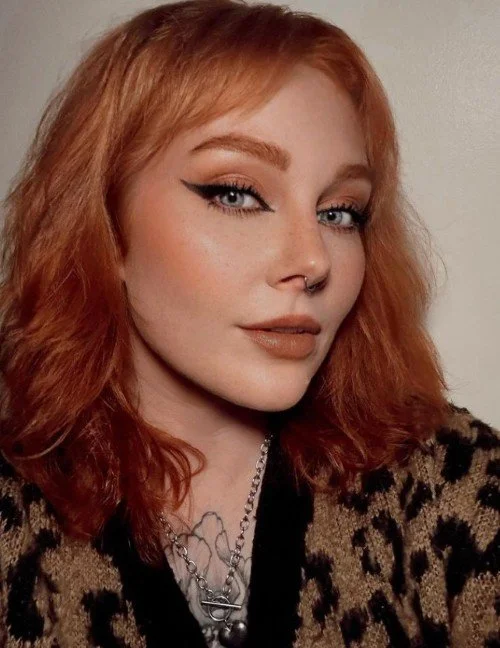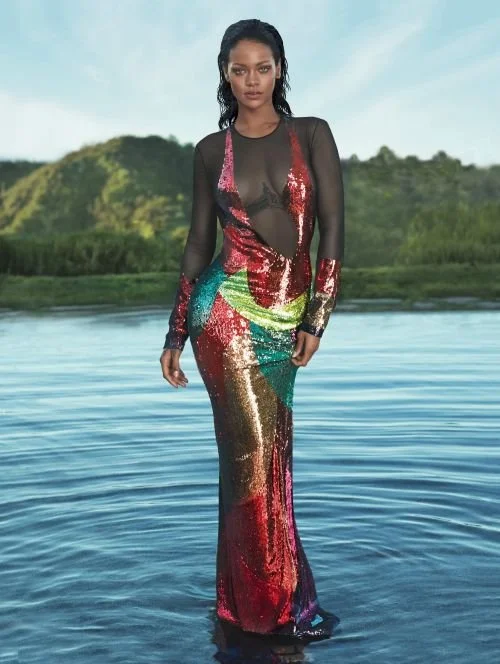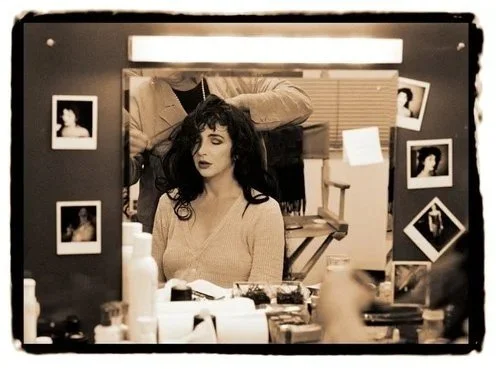FEATURE:
Kate Bush: Something Like a Song
IN THIS PHOTO: Kate Bush in 1989/PHOTO CREDIT: Guido Harari
Never Be Mine (The Sensual World)
__________
THERE are not too many songs…
I can include in this feature without repeating myself. The thing is that a lot of Kate Bush songs have little written about them. However, I have been fascinated by her deeper cuts. Those songs that are not exactly obscure, yet they do not get talked about a lot and people are not going to highlight them much. One is Never Be Mine from 1989’s The Sensual World. Its title might suggest a basic love song. I think some people (Graeme Thomson for one) criticised The Sensual World for burning at a lower heat than Hounds of Love. How it is less extraordinary than that 1985 album, and there are songs that are inessential and Kate Bush is not at her (expected) best. I have seen Never Be Mine highlighted as one such song that falls short of expectation and previous standards. I know that Never Be Mine was a possibility for Bush’s 2014 residency, Before the Dawn. A recording of the song, supposedly from initial rehearsals, is included on the C.D. and L.P. versions of Before the Dawn. On the physical versions of the album, you hear Never Be Mine after Top of the City in Act I. It is an extraordinary and powerful vocal from Kate Bush that should put some eyes back on the original. Although it is one of the most-streamed songs from The Sensual World on Spotify, it is still just over three million. It is quite low. I feel Never Be Mine could have been a single from the album. Love and Anger is great but, if we think of strong songs that were not brought out as singles, Never Be Mine and Deeper Understanding spring to mind. In terms of articles written about Never Be Mine, there is not a whole lot. However, it is a fascinating song. Its positioning on The Sensual World is interesting. On the second side after Between a Man and a Woman – one of the lesser cuts from the album – and before the extraordinary penultimate number, Rocket’s Tail – which I have explored for a future feature, and is a natural highlight from The Sensual World -, Never Be Mine was perhaps a song Bush felt less sure about. Wanting to positioning it lower in the album.
That being said, Kate Bush did re-record Never Be Mine for 2011’s Director’s Cut. That would indicate she was not happy about the production sound or feel of the original, but that she did like the song enough to take the effort to do that. I think the Director’s Cut version is fine, though the superb version on The Sensual World is the best. I think it is absolutely wonderful, so maybe Bush re-recorded it to give it some attention or a new focus. In terms of the lyrics and its story, it would make sense she would re-approach it as an older woman. Just in her thirties when it was released on The Sensual World, Bush was fifty-two when the Director’s Cut version was released. Even though it not a massive streaming success, Never Be Mine has a rare distinction of being included on a studio album, Director’s Cut and Before the Dawn. Few other songs can claim that honour (pub trivia territory if you can name any other songs!). Bush did her best with the original, but she wanted to come back to it for Director’s Cut. Keen to bring it to the stage, I am curious about the decision not to include it in the set. However, it does make me think that this is a track more people should know about. I am going to discuss it further. However, I want to come to the Kate Bush Encyclopedia article about Never Be Mine and some interview archive, where Kate Bush talked about the song’s background:
“It’s that whole thing of how, in some situations, it’s the dream you want, not the real thing. It was pursuing a conscious realisation that a person is really enjoying the fantasy and aware it won’t become reality. So often you think it’s the end you want, but this is actually looking at the process that will never get you there. Bit of a heart-game you play with yourself.
Len Brown, ‘In The Realm Of The Senses’. NME (UK), 7 October 1989
I wanted a sort of eastern sounding rhythm. I wrote it first on the piano, though the words were completely different, except for the choruses. I did it on the piano to a Fairlight rhythm that Del programmed – I think that maybe because of the quality of the sounds, it was harder for Del to come up with the patterns. And I was more strict – he found it much harder. I think the pattern in ‘Heads We’re Dancing’ is really good – really unusual, the best he came up with. But ‘Never Be Mine’ was kind of tabla based. We got Eberhard (Weber) over to play bass and he played on the whole song. When we were trying to piece it together later we kept saying it just doesn’t feel right, so we just took the bass out and had it in these two sections.
Tony Horkins, ‘What Katie Did Next’. International Musician, December 1989”.
There is so much to unpack when it comes to the lyrics. These lines are especially intriguing and stirring: “I want you as the dream/Not the reality/That clumsy goodbye-kiss could fool me/But I’m looking back over my shoulder/At you, happy without me”. I am not sure if they were written about Del Palmer – who Bush was in a relationship with at this point, though I suspect it was breaking down (I am never 100% sure if they broke up around 1993 or at the end of the 1980s), or if it was not based on anyone. Singing it in 2014, it would have taken on new meaning. Memories and reminiscence rather than something that held as much meaning and emotion than back in 1989. What makes Never Be Mine so enduring and compelling is its richness and simplicity. In terms of musicians, it is not packed to the rafters with bodies. You have Davy Spillane on Uilleann pipes that adds this Celtic/Irish beauty and yearning. Wonderful bass from Eberhard Weber. The Trio Bulgarka providing vocals. That clash of countries, cultures and sounds. It is a mix that works wonderfully! That idea of wanting someone in a dream but not a reality. We can all relate to that. “The thrill and the hurting/I know that this will never be mine”. You can hear genuine hurt in Bush’s voice…making me wonder whether it was based on her relationship at the time. Although she had revealed her hurt and opened her heart on previous albums, The Sensual World has a few songs where she does this. As potently as on Hounds of Love or any of her other albums. I have seen a review that called Never Be Mine a “haunting exploration of desire, fantasy, and the emotional complexity of unattainable love”. Is it unobtainable love or something that seems ideal in your head, but the reality is not as desirable as hoped?! That first verse where she sings “My life that might have been/Your face just ghostly in the smoke/They’re setting fire to the cornfields”. Poetic, stark and devastating, I see those lines as the embers of a long-term relationship where maybe Bush foresaw a different ending or future. However, there is tension and division, so the person that she thought she might spend her life was is not that person anymore.
Just prior to getting to a feature about the song, I want to move to some critical snapshots and opinions of Never Be Mine (the version on The Sensual World). In an extremely generous and adoring review from Pitchfork - who still don’t give many albums high kudos; this 2019 review seemed like someone had spiked the water supply! -, this was observed: “To hear someone recall formative childhood truths (the lush grandeur of “Reaching Out”) and lingering romantic pipedreams (the longing of “Never Be Mine”) is like being given a reel of their memory tapes and discovering what makes them tick”. The Quietus marked thirty years of The Sensual World in 2019 and put this in their sub-headline/by-line: “Burning fields, black November nights, the swirling beauty of the Uilleann pipes…”. That could apply to the title track, though it ticks all the boxes for Never Be Mine. They add that “Kate Bush made the perfect soundtrack to autumn”. Never Be Mine seems very autumnal. The leaves have fallen and the nights are drawing in. That sense of loss or impending separation in the chill. Such an evocative song! Their opening section of the review spotlights Never Be Mine:
“They’re setting fire to the cornfields/ as you’re taking me home" So sang Kate Bush thirty years ago on the majestic ‘Never Be Mine’, a forlorn ballad of yearning that radiates from its parent album, The Sensual World with understated autumnal grace. It is a song that still conjures the same images for me every time I hear it – an early evening sunset in October, birds departing a harvested field, the sunlight low and fading on the horizon. Eberhard Weber’s bass has a throbbing beauty that weaves around Kate’s piano like a cloak, while the strident vocals of the Trio Bulgarka merge with the melancholic Uilleann pipes to evoke all sorts of emotions – sadness, hope, reflection, loss, longing. Beginnings. Endings. It doesn’t matter when I hear it, what time of year, or in what context – it is immediately transportive…
The smell of burning fields / will now mean you and here," she sings. Well, quite. Autumn, for me anyway, encapsulates all of these things. It’s both a beginning and an ending, a time of reflection and anticipation; it bridges the warmth and joy of summer and the barren starkness of winter. Music is an art that can suggest a sense of time and place like no other – and has there ever been an artist who so emotively captures the mood and texture of the seasons as Kate Bush?”.
Five years before that mention of Never Be Mine, The Quietus looked at Kate Bush’s best and most revealing songs beyond the hits. Tying it to Before the Dawn in 2014, Lisa Jenkins observed the following: “Never Be Mine’ is a thing of beauty which showcases Bush’s amazing vocal range in its entirety, and has the ability to make the hairs at the nape of your neck stand up. The lyrics are heart wrenching, full of unrequited love and yearning, suited to my angst ridden fifteen-year-old self at the time, the song itself like a fire coloured painting with nature, love and lust intermingling. The album in general is one of her strongest, and bought teenage girls and boys of the 90s screaming into their own, individual, sexual awakenings”. Pop Dose spent some time with a Kate Bush work of brilliance in 2008:
“Never Be Mine” is just what the title suggests: the story of a woman who still pines for a lover who’s moved on. The chorus is the song’s biggest hook, where Kate lays it all on the table by admitting, “This is where I want to be, this is what I need / But I know that this will never be mine.” However, she does something even more clever in the first verse:
I look at you and see, my life that might have been
Your face just ghostly in the smoke
They’re setting fire to the cornfields, as you’re taking me home
The smell of burning fields, will now mean you and here
By associating a sensory perception with a memory, she has guaranteed that people will do the exact same thing with this song. Music of all kinds always reminds people of a time and a place, and Kate is basically doubling down that you will do the same. And she’s dead right. I, for one, cannot hear this song without thinking of a specific time — and person — every time I hear it, regardless of how much time has passed since the year and girl in question. That’s powerful stuff, kids, and it doesn’t hurt to have the fabulous Trio Bulgarka doing the heavy lifting with the backing vocals.
The opening lines to the second verse have a certain brazen honesty to them as well: “I want you as the dream, not the reality.” Is she saying that she understands why she and her beloved are not together but still pines for the pipe dream anyway? Wow. Show me a pop song today with that much self-awareness and maturity. Okay, I’m kidding, stop looking. It doesn’t exist”.
Even if Pop music has matured since 2008, and modern-day artists might be able to match Never Be Mine, it is amazing that some critics in 1989 and since overlook or look down their noses at The Sensual World when one of its deep cuts is Never Be Mine! Alongside the best-known songs – The Sensual World and This Woman’s Work -, there are some phenomenal gems that do not get exposed enough. Both heartbreaking but relatable, Never Be Mine is this song that started out in 1989, was reworked in 2011, then almost made its way into the set list for 2014’s Before the Dawn. It did get onto the 2016 live album, so has enjoyed this span of twenty-seven years. I’d like to think that this song will feature in a future chapter of Kate Bush’s career, as it really is…
ONE of her best.









































































